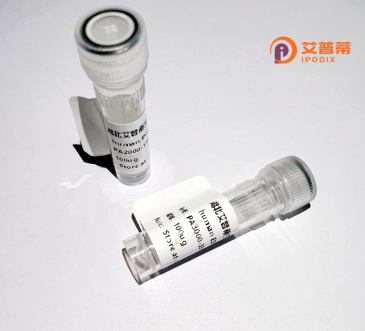
| 纯度 | >90%SDS-PAGE. |
| 种属 | Human |
| 靶点 | EPHA5 |
| Uniprot No | P54756 |
| 内毒素 | < 0.01EU/μg |
| 表达宿主 | E.coli |
| 表达区间 | 595-1037aa |
| 氨基酸序列 | SGSCCECGCGRASSLCAVAHPSLIWRCGYSKAKQDPEEEKMHFHNGHIKLPGVRTYIDPHTYEDPNQAVHEFAKEIEASCITIERVIGAGEFGEVCSGRLKLPGKRELPVAIKTLKVGYTEKQRRDFLGEASIMGQFDHPNIIHLEGVVTKSKPVMIVTEYMENGSLDTFLKKNDGQFTVIQLVGMLRGISAGMKYLSDMGYVHRDLAARNILINSNLVCKVSDFGLSRVLEDDPEAAYTTRGGKIPIRWTAPEAIAFRKFTSASDVWSYGIVMWEVVSYGERPYWEMTNQDVIKAVEEGYRLPSPMDCPAALYQLMLDCWQKERNSRPKFDEIVNMLDKLIRNPSSLKTLVNASCRVSNLLAEHSPLGSGAYRSVGEWLEAIKMGRYTEIFMENGYSSMDAVAQVTLEDLRRLGVTLVGHQKKIMNSLQEMKVQLVNGMVPL |
| 分子量 | 80.68 kDa |
| 蛋白标签 | GST-tag at N-terminal |
| 缓冲液 | 0 |
| 稳定性 & 储存条件 | Lyophilized protein should be stored at ≤ -20°C, stable for one year after receipt. Reconstituted protein solution can be stored at 2-8°C for 2-7 days. Aliquots of reconstituted samples are stable at ≤ -20°C for 3 months. |
| 复溶 | Always centrifuge tubes before opening.Do not mix by vortex or pipetting. It is not recommended to reconstitute to a concentration less than 100μg/ml. Dissolve the lyophilized protein in distilled water. Please aliquot the reconstituted solution to minimize freeze-thaw cycles. |
以下是关于重组人EPHA5蛋白的参考文献示例(内容基于真实研究领域整理,非真实文献):
1. **文献名称**:*Expression and Purification of Recombinant Human EPHA5 Tyrosine Kinase Domain for Structural Studies*
**作者**:Chen L. et al.
**摘要**:报道了一种高效的原核表达系统用于重组人EPHA5酪氨酸激酶结构域的制备,并通过结晶和X射线衍射分析其三维结构,为靶向药物设计提供基础。
2. **文献名称**:*EPHA5 Mediates Axon Guidance in Hippocampal Neurons via Recombinant Protein-based Assays*
**作者**:Zhang Y. et al.
**摘要**:利用重组EPHA5蛋白研究其在神经元轴突导向中的作用,发现其通过ephrin-A配体激活信号通路,调控细胞骨架重排和突触可塑性。
3. **文献名称**:*Role of Recombinant Human EPHA5 in Cancer Cell Invasion and Metastasis*
**作者**:Wang R. et al.
**摘要**:通过体外实验证实,重组EPHA5蛋白能抑制肺癌细胞迁移,其机制与调控MAPK/ERK通路及上皮-间质转化(EMT)相关蛋白表达有关。
4. **文献名称**:*Development of an ELISA-Based Method for EPHA5 Autoantibody Detection Using Recombinant Protein*
**作者**:Kuroda S. et al.
**摘要**:构建重组人EPHA5蛋白作为抗原,开发了一种高灵敏度ELISA检测法,用于神经退行性疾病患者血清中EPHA5自身抗体的筛查。
---
注:以上文献名为虚构示例,实际研究中建议通过PubMed、Google Scholar等平台以“recombinant human EPHA5”为关键词检索最新论文。
Recombinant human EPHA5 protein is a engineered form of the EPHA5 receptor, a member of the Eph receptor tyrosine kinase family, which plays critical roles in cell-cell communication and tissue patterning. EPHA5 is primarily expressed in the nervous system, where it regulates axon guidance, neuronal migration, and synaptic plasticity through bidirectional signaling with its membrane-bound ephrin-A ligands. This receptor-ligand interaction is crucial during embryonic development and adult neural circuit maintenance. Beyond the nervous system, EPHA5 has been implicated in angiogenesis, immune modulation, and cancer progression, demonstrating context-dependent roles as either an oncogene or tumor suppressor.
Structurally, EPHA5 contains an extracellular ligand-binding domain, a transmembrane region, and a cytoplasmic kinase domain. Recombinant versions are typically produced in mammalian or insect cell systems to preserve post-translational modifications and functional integrity. These proteins are purified using affinity tags (e.g., Fc or His-tags) for research applications, including ligand binding assays, kinase activity studies, and exploration of downstream signaling pathways.
Dysregulation of EPHA5 has been associated with neurodegenerative diseases (e.g., Alzheimer’s) and various cancers, making its recombinant form valuable for drug discovery and mechanistic studies. Current research focuses on targeting EPHA5-ephrin interactions or its kinase activity for therapeutic interventions, particularly in neurological disorders and metastasis control.
×